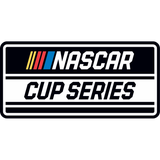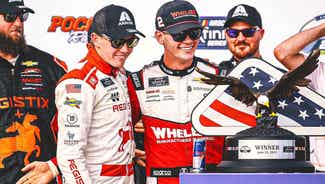
NASCAR delivers Next Gen chassis, answering some questions and raising others
By Bob Pockrass
FOX Sports NASCAR Reporter
NASCAR teams began receiving the Next Gen chassis last week. Let the assembling begin, and maybe, let some of the angst wane.
Maybe.
NASCAR has a major task over the next six months leading into the 2022 Daytona 500. Any new car that is introduced into racing organically brings concerns among those who make a living trying to take that car and win with it.
The Next Gen has been no exception, and the dynamics of this extreme shift in how teams field race cars have created a predictably high level of concern.
Those concerns were compounded in the past couple of months as teams had hoped that NASCAR would start distributing the chassis by mid-June at the latest, but NASCAR didn’t want to deliver it to the teams until its independent safety panel had reviewed the results of a crash test.
The crash test ended up getting delayed to June 30, and the panel gave the chassis the OK a couple of weeks later. NASCAR sent a summary of the panel’s findings to the teams and began distribution of the chassis last week.
For more up-to-date news on all things NASCAR, click here to register for alerts on the FOX Sports app!
"I read the summary and will rely on the drivers and the technical guys to interpret a lot of it," Roush Fenway Racing President Steve Newmark said last week.
"There seemed to be a lot of comfort with the results and the direction that it is headed."
NASCAR will go over the results with drivers in the next few weeks in hopes of alleviating any major concerns over the safety of the vehicles.
Meanwhile, testing has continued, primarily with each manufacturer having its prototype car running for a few days monthly at a track in order to gather data that can be used in their simulation programs.
In late June, the manufacturers were at Dover. This week, they have been at Texas. Toyota’s Texas test lasted less than a day after a crash — a Toyota spokesman said they had an issue, but Denny Hamlin tweeted "RIP" to the car, which was being driven by Toyota test driver Drew Herring.
That isn’t a total surprise — pretty much every driver who has tested the car has talked about how it is more difficult to drive than the current Cup car. Chip Ganassi Racing driver Ross Chastain said the springs and shocks are different and he almost crashed on his first lap at Dover in being too loose with the initial setup they had in the Chevrolet prototype car.
"It was a little slower, a little less power than what we had [with the current car] at Dover and less grip overall," Chastain said.
"The steering wasn’t quite keeping up on corner exit. I was manually steering. ... They’ll go back and tweak it and make it better."
NASCAR has more manufacturer and Goodyear tire tests — typically three cars but possibly at Daytona with more than three — scheduled in the next couple of months. The first test with what could be at least a dozen cars is expected to be the first organizational test — one car per organization — that is set for mid-October on the Charlotte road course.
While NASCAR has not made its testing schedule public, team executives have indicated that it is important to have their 2022 lineups solidified by then so they know who should be doing that October test.
From now until then, teams will be busy assembling the cars. Unlike previously where teams either built their own chassis or bought them from a private chassis building company, the main parts and pieces (other than the engine) will come from a single provider. The bodies for each manufacturer are a different shape, but they all will come from Five Star Race Car Bodies.
The biggest focus likely will be on chassis manufacturer Technique, which has provided chassis to various teams for decades. Technique has settled into a shop in Concord, N.C., and has hired people from several teams to oversee the process and construct the chassis.
Formed in Michigan by Ronnie Johncox, a former racer himself who has eight IndyCar starts, Technique can build 25-30 chassis a month. Its contract with NASCAR is to build a minimum of 200 chassis a year with the ability to scale up to 500.
Technique has about 30 employees, many with extensive experience at race teams, and the shop is running about 12 hours a day, Johncox told FOX Sports during a tour of his facility in May. They also use specifically built robots to do much of the welding – about 95% of the front clip is done robotically and a significant percentage of the center and rear clips can be done robotically as well.
That guarantees the same weld every time. The finished clip (the chassis is made up of three parts – front clip, center clip and rear clip) has a QR code that details thousands of points of measurement on the chassis. The chassis go to NASCAR, which distributes them (chartered teams will get a chassis before open teams), and the teams can then use the QR code to see the measurements of their chassis that has more than a thousand data points. That data can then also be used after a crash to assess damage when re-measuring those data points.
The expected rule will be that teams will be able to have seven active chassis at any one time. NASCAR will set up a process for teams to get a new chassis after a crash or how many races a team must use a chassis before requesting a replacement, as well as any process for a chassis to be transferred from one organization to another. The smaller teams with less funding obviously would be in the market for used chassis – they are used to buying cars that the big teams have cycled out of their fleet because of age or not having the most recent technology.
"The idea is you want to keep car counts down as much as possible," Joe Gibbs Racing President Dave Alpern said. "The idea is trying to protect teams from themselves. Otherwise, you’ll build 20 of everything just to have them sitting there."
Technique has been building chassis (the chassis was designed by Dallara) for several months. The early versions of the chassis — a project like this will have some trial-and-error in the manufacturing process — will be used for show cars.
Teams have asked for more than 100 chassis just for show cars — cars that are used for promotional events that in the past would just be an old car that has outlived its usefulness on the track. It is important to teams and sponsors that those cars reflect what is on the track.
For now, though, the focus is on the cars that will actually race. Teams obviously have eagerly awaited parts and pieces. Naturally, teams are worried they won’t have enough parts and pieces for the cars.
Those concerns are the same as when NASCAR has introduced new cars over the last 15 years. And yet no one missed a race because a part or piece wasn’t done. So those who have been around to see past transitions are trying to keep from hitting the panic button.
"The good thing about a project like this is that it is the same for everyone," Alpern said. "They went through a pretty robust vetting process on this and the people that got picked know what they’re doing."
What makes this different is neither the teams nor the manufacturers are responsible for the manufacturing schedule. So instead of just worries about whether raw materials or other pieces they would have to purchase are available or make alternative plans if they are not, teams are at the mercy of the vendors, many of which will then send the products to a NASCAR-approved distributor in order to avoid any accusations of favoritism. Throw in pandemic concerns over computer chips, availability of labor, shipping delays, etc., and it’s easy to see why there are concerns.
That has led to speculation that the cars might not be ready. NASCAR has brushed off those comments, partly attributing them to those who don’t want to see the car completed.
There are two reasons for that: Having vendors provide virtually all parts and pieces has rattled the foundation of the NASCAR culture of using ingenuity to building a car to go as fast as possible, leading to many disgruntled racers. Plus, teams have either laid off employees (such as fabricators) whose jobs have now become obsolete, not replaced employees who have left or have told employees they won’t have jobs.
Many teams have seen employees already leave, and don’t even have the infrastructure to build a new fleet of cars if NASCAR has an issue with a vendor of a specific part, creating even more concern and speculation on "what-if" scenarios.
The vendors have had to beef up their workforce. And there is the possibility that some small teams will have to add people in order to assemble the cars – there won’t be buying any old cars from other teams for at least part of next year. But overall, one of the pillars of the Next Gen car is that teams will be able to compete with a reduced workforce.
What that reduction will be as far as percentage of the current workforce remains to be seen once teams have a true idea of the labor they need to assemble the cars and what areas where they still will be responsible for themselves.
Thinking Out Loud
It has been 30 years since NASCAR last had two weeks off scheduled for the NASCAR Cup Series, so it’s no surprise that fans are getting a little antsy over two consecutive weekends during the 2021 season.
The two consecutive weeks off, originally scheduled for 2020 until the pandemic caused NASCAR to suspend the season and then revise the schedule, is the result of the Olympics.
With NBC having both the NASCAR Cup Series and the Olympics at this time, the idea was to not try to shoehorn a Cup race amid Olympic coverage and also have to deal with any potential contingency plans for weather. It also kept NASCAR from going head-to-head against an Olympic event.
It makes sense, and while it could cause a little frustration among fans and a little numbing of momentum built throughout the summer, it isn’t the worst thing to happen to NASCAR’s schedule. Certainly teams like the break, but having one week off has proven enough during the summer for most teams to get a quick respite and refuel themselves for the remainder of the season.
Like any decision, it should be evaluated. The good thing is NASCAR has a couple of years before deciding on the 2024 schedule and whether it should consider another two-week break during the Olympics.
Social Spotlight
They Said It
"I was good for five spins a test session it seemed like, and I've been able to pull that back quite a bit and not spin on some weekends, which has been nice." — Jimmie Johnson on his transition to IndyCar
Bob Pockrass has spent decades covering motorsports, including the past 30 Daytona 500s. He joined FOX Sports in 2019 following stints at ESPN, Sporting News, NASCAR Scene magazine and The (Daytona Beach) News-Journal. Follow him on Twitter and Instagram @bobpockrass.







